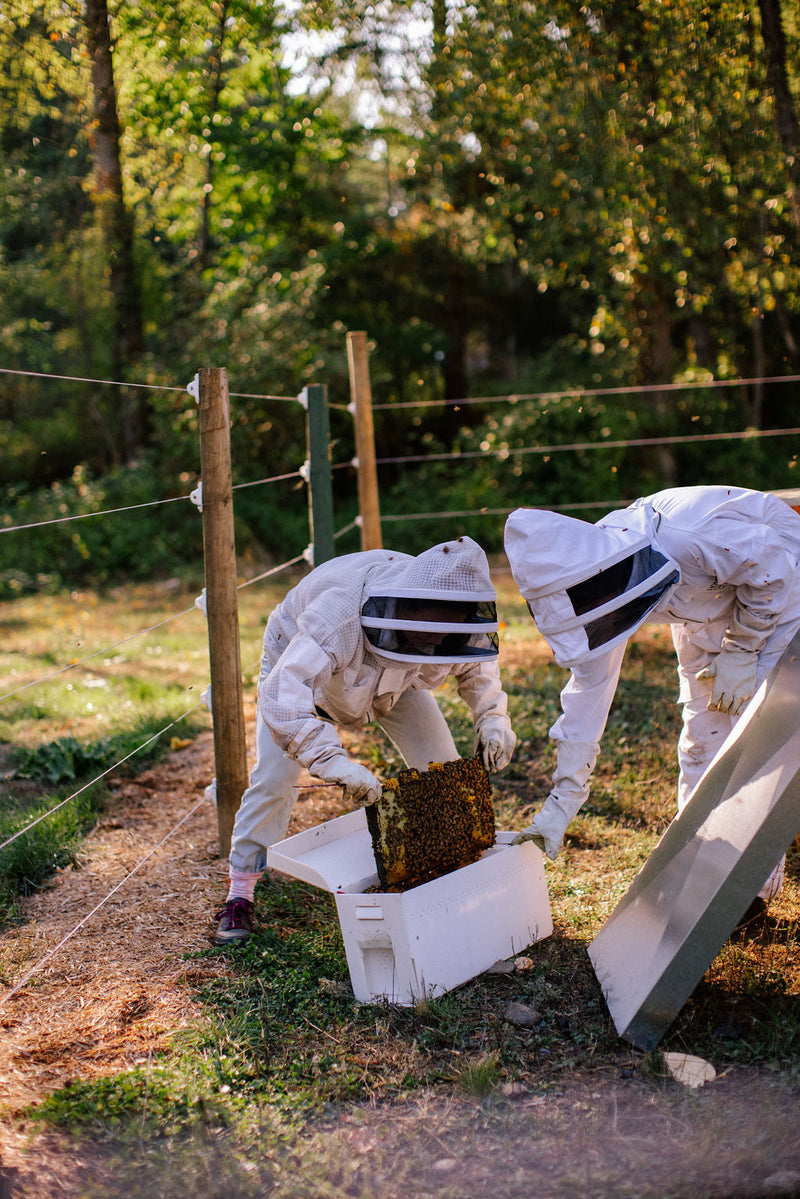
A glimpse of sunshine and later sunsets- it's a friendly reminder that spring is here and warmer days are just around the corner! In dreaming up garden ideas and warm weather adventures, you may also have a reoccurring question: is this the year I start beekeeping?
If this is the year you start beekeeping, you're going to need hive equipment, live bees and educational resources. Let's start with resources:
Local Bee Clubs:
Bee clubs are organizations focused on supporting the local beekeeping community. This wonderful resource is available throughout the entire beekeeping season- which is very, very helpful! Bee clubs are a place where you have the opportunity to meet other beekeepers, learn from guest speakers, ask questions and listen to discussions about the seasonal steps of beekeeping. Bee club meetings are typically held once a month either online or in person. Some bee clubs have rental equipment such as extractors or observation hives, that you can access throughout the year. To find a bee club in your region follow the link: https://bchoneyproducers.ca/info-for-beekeepers/bc-bee-clubs/.
Apiary Inspectors:
Apiary inspectors are employed by the government to help prevent the spread of apiary diseases. If you suspect your colony has any pest or disease, calling your local apiary inspector is important! Apiary inspectors (or bee inspectors) can schedule a hive inspection (at your apiary) and help provide guidance on disease/pest management. This service is free! Apiary inspectors are also important for selling local bees or used equipment. To find out who the apiary inspector is for your region, follow the link: https://www2.gov.bc.ca/gov/content/industry/agriculture-seafood/animals-and-crops/animal-production/bees/apiculturist-inspectors
BCHPA:
The BC Honey Producers Association was established in 1920. It is an organization for all beekeepers in BC. It is a hub for beekeeping education and initiatives. You can sign up to be a member via the website below. The membership gives you access to educational material, resources and a monthly magazine packed full of information.
Local Bee Shop:
I suggest that you connect with a local bee supply store! Bee stores are usually full of information, up to date products and typically a place where you can order live bees! I encourage you to connect with local beekeepers and find a store near you- support local!
https://bchoneyproducers.ca/info-for-beekeepers/suppliers-buyers-sellers-index/suppliers/
Courses & Workshops:
Courses are great ways to meet a local educator and learn the foundations of beekeeping, giving you the tools and knowledge needed to help you start your beekeeping season. At Home Grown Bee, we have a fully online, self paced course that is on sale for the month of April! If you are a hands on learner, reach out to your local bee store, bee club or community to see if there are any available workshops or field days- this is where you go to someone's apiary, head into their hives and learn hands on!
Books- there are so many wonderful books, but here are a few:
- Queen Spotting Book by Hilary Kearney
- The Beekeeper's Handbook 5th edition by Diana Sammataro and Alphonse Avitabile
- Honeybee Pests & Disease Published by Canadian Association of Professional Apiculturists
Social media resources:
- Facebook has lots of beekeeping groups, some nation wide and some as local as your specific community. If you are on Vancouver Island, the VI Beekeepers group on Facebook is a great way to connect with local beekeepers.
Why is it important to connect with a network of beekeepers? Well, as you learn to manage honeybee colonies, you will be filled with questions and may find it helpful connecting with beekeepers that may have dealt with similar issues in their beekeeping history. They may be able to suggest hive management techniques or help alert you to upcoming seasonal needs of your hive. At Home Grown Bee, we know we've found it incredibly helpful connecting with our beekeeping community throughout the seasons!
Feeling a bit overwhelmed by all the beekeeping equipment out there? Let's break it down.
If this is the year you’re getting bees, you’ll need the right tools. At Home Grown Bee, we’ve curated a variety of beekeeping kits to help you get started. Let’s take a closer look at a Starter Kit, designed for one hive.
What’s Included:
-
1 x Telescopic Hive Top
-
1 x Inner Cover
-
1 x Bottom Board (regular or screened)
-
2 x Deep Supers (or medium supers)
-
20 x Wood Frames
-
20 x Plastic Foundation
-
1 x Frame Feeder
-
1 x Hive Tool
- 1 x Entrance Reducer
You can choose between two variations:
Deep or Medium Set-Up: The deep boxes (9 5/8”) are larger and heavier when full, while the medium boxes (6 5/8”) are lighter and easier to manage. For beginners, deep boxes may feel challenging, but you can always remove frames to lighten the load. Pro tip: Keep uniform equipment for your bottom two (deeps) or bottom three (mediums) boxes to make frame swapping easier.
Regular or Screened Bottom Board:
-
-
Regular Bottom Board: A solid wooden base with no extra ventilation. Tilting it slightly allows water to flow out of the hive entrance.
-
Screened Bottom Board: Features a mesh bottom and a removable board beneath. This setup offers added ventilation in the summer and lets you monitor mite drops during treatments. Both types work well with proper management, so it’s a matter of preference.
-
Getting Started with Confidence
We know there’s a lot to learn as you begin your beekeeping journey, but our kits are thoughtfully designed to make the process smoother. Whether you opt for deep or medium equipment, regular or screened bottom boards, your bases are covered. Overtime you will find equipment sizes or specific supplies that you like to work with the most! Just rest assured that the bees are adaptable and all options provide a safe home for the bees.
